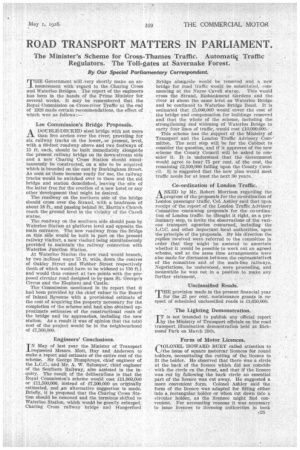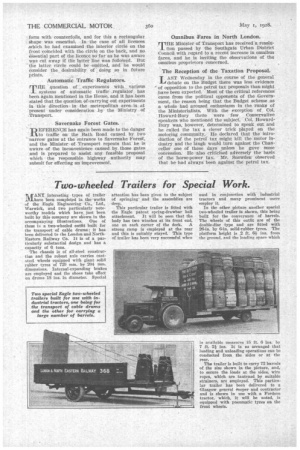ROAD TRANSPORT MATTERS IN PARLIAMENT.
Page 47

Page 48

If you've noticed an error in this article please click here to report it so we can fix it.
The Minister's Scheme for Cross-Thames Traffic. Automatic Traffic Regulators. The Toll-gates at Savernake Forest.
By Our Special Parliamentary Correspondent.
THE Government will ,very shortly make an announcement with regard to the .Charing Cross and Waterloo Bridges. The report of the engineers has been in the hands. of the Prime Minister for several weeks, It may be remembered that the Royal Commission on•Cross-river Traffic at the end of 1926 made certain recommendations, the effect of which was as follows:— Lee Commission's Bridge Proposals.
ADOUBLE-DECKED steel bridge with not more than five arches over the river; providing for six railway tracks on the lower, or present, level,
with a 60-foot roadway above and twO footways of 15 ft. each, should be built immediately alongside the present railway bridge on its down-stream side and a new Charing 'Cross Station should simultaneously be constructed, on a site to be acquired which is bounded on the east by Buckingham Street.
As soon as these became ready for use, the railway tracks would be switched over to them and the old
bridge and station demolished, leaving the site of the latter free for the erection of a new hotel or any other -development that might be desired.
The road-way on the northern side of the bridge . Should cross over the Strand, with a headroom of about 18 ft., and passing behind St. Martin's Church reach the ground level in the vicinity of the Cavell statue.
The roadway on the southern side should pass by Waterloo Station at platform level and opposite the main entrance. The new roadway from the Fridge on this side would be built in part on the present railway viaduct, a new, viaduct being simultaneously provided to maintain the railway connection with Waterloo Junction Station,
At Waterloo Station the new road would branch, by two inclined ways 75 ft. wide, down the centres of Oakley Street and Webber Street respectively (both of which would have to be widened to 150 ft.) and would thus connect at two points with the proposed circular road designed to by-pass St. George's Circus and the Elephant and -Castle.
The Commission mentioned in its report that it had been provided by the chief valuer to the Board of Inland Revenue with a provisional estimate of the cost of acquiring the property necessary for the completion of the scheme and had also obtained ap proximate estimates of the constructional costs of the bridge and its approaches, including the new station. As a result it was of opinion that the total cost of the project would be in the neighbourhood of 1.7,500,000.
Engineers' .Conclusions.
IN May of last year the Minister of Transport requested Messrs. Mott, Hay and Anderson to make a report and estimate of the entire cost of the scheme. Sir George Humphreys, chief engineer of the L.C.C., and Mr. A. W. Szlumper, chief engineer of the Southern Railway, also assisted in the inquiry. The result of the deliberations is that the Royal Commission's scheme would cost 111,000,000 or 111,500,000, instead of 17,500,000 as originally estimated, and ,an alternative suggestion is made. Briefly, it is proposed that the Charing Cross Station should be removed and the terminus shifted to Waterloo Station, which would he greatly enlarged. Charing Cross railway bridge and Hungerford
Bridge alongside would be removed and a new bridge for road traffic would be substituted, commencing at the Nurse Cavell statue. This would MOSS the Strand, Embankment Gardens and the river at about the same level as Waterloo Bridge and be continued to Waterloo Bridge Road. It is estimated that 15,000,000 would cover tile cost of the bridge and compensation for buildings removed and that the whole of the scheme, including the strengthening and widening of Waterloo Bridge to carry four lines of traffic, would cost 110,000,000.
This scheme has the support of the Ministry of Transport and the London Traffic Advisory Corn-' mittee. The next step will be for the Cabinet to consider the question, and if it approves of the new scheme the County Council will be asked to consider it. It is understood that the Government would agree to bear 75 per cent. of the cost, the remaining 12,500,000 falling upon the County Council. It is suggested that the new plan would meet traffic needs for at least the next 30 years.
Co-ordination of London Traffic.
A SKED by Mr. Robert Morrison regarding the 1-1progress of the proposals for tile co-ordination of London passenger traffic, Col. Ashley said that upon receipt of the report of the London Traffic Advisory Committee containing proposals for the co-ordination of London traffic he thought it right, as a preliminary step, to invite the observations of the various transport agencies concerned, including the L.C.C. and other important local authorities, upon the principle of the proposals. By his direction the replies received were referred to the committee in order that they might be assisted to ascertain whether it would be possible to work out an agreed scheme, and at the same time arrangements were also made for discussion between the representative of the committee and of the main-line railways. Negotiations, he understood, were proceeding, and meanwhile he was not in a position to make any further statement.
Unclassified Roads, T"provision 'made in the present financial year for the 25 per cent, maintenance grants in respect of scheduled unclassified roads is 11,650,000.
The Lighting Demonstration.
IT is not intended to publish any official report by the Ministry of Transport officials on the road transport illumination demonstration held at Richmond Park on March 29th.
Form of Motor Licences.
CIOLONEL HOWARD BURY called attention to Lithe issue of square motorcar licences for round holders, necessitating the cutting of the licence to fit the holder. He observed that there was a circle at the back of the licence which did not coincide with the circle en the front, and that if the licence was cut by following the back circle an essential part of the licence was cut away. He suggested a more convenient form. Colonel Ashley said the form of the licence was adapted for fitting either into a. rectangular holder or when cut down into a circular holder, as the licensee might find convenient. For accounting reasons it was necessary to issue licences to licensing authorities in book form with counterfoils, and for this a rectangular shape was essential.. In the ease of all licences .which he had examined the interior circle on the front coincided with the circle on the back, and no essential part of the licence so far as he was aware was cut away if the latter line *as folloWed. But the latter circle could be omitted, and he would consider the desirability of doing so in future prints. •
Automatic Traffic Regulators.
T" question of experiments with _ various systems of automatic traffic. regulator has been again mentioned in the House, and it has been stated that the question oftearrying out experiments in this direction in the metropolitan area is. at present under consideration -by the Ministry of .Transport.
Savernake Forest Gates.
REFERENCE has again been made to the danger itto traffic on the Bath Road caused by two narrow gates at the entrance to Savernake Forest, and the Minister of Transport repeats that he is aware of the inconvenience caused by those gates and is prepared to assist any feasible proposal -which the responsible highway authority may submit for effecting an improvement. Omnibus -Fares in North London.
TMILE Minister of Transport has received-a resolui. tion passed by the Southgate Urban District Council with regard to a recent increase in omnibus fares, and he is inviting the observations of the omnibus proprietors concerned.
The Reception of the Taxation Proposal.
LAST Wednesday in the course of the general -1-1 debate on the Budget there was less evidence of opposition to the petrol tax proposals than might have been expected. Most of the critical references came from the political opponents of the Government, the reason being that the Budget scheme as a whole had aroused enthusiasm in the ranks of the Ministerialists. With the exception of Col. Howard-Bury there were few Conservative speakers who mentioned the subject. Col. HowardBury was, however, determined to speak out and he called the tax a clever trick played on the motoring community. He declared that the-introduction of the petrol tax might kill the motor industrY and the laugh would turn against the Chancellor one of these days unless he gave some concession. He ,also criticised adversely the basis of the horse-power tax. Mr. Snowden observed that he had always been against the petrol tax.












































































































